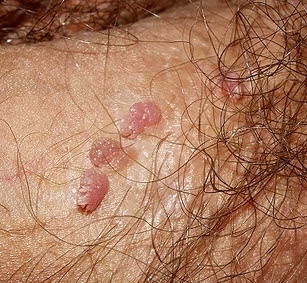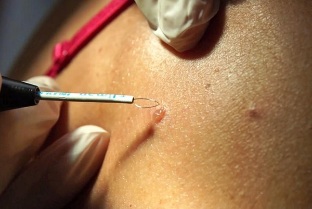
More often, people do not suspect that they have the human papillomavirus (HPV) in their body. This is due to the fact that the papillomavirus is usually in a latent form, which is suppressed by natural immunity. Problems arise when it gets out of control and begins to take the form of growths in different parts of the body. Men are less likely to suffer from the effects of the virus than women, but their effects can turn into serious papilloma problems on the penis.
Causes of the event
Viral DNA enters the body through microcracks in the skin or mucous membranes. If a man's immunity is weakened, the first signs of HPV will appear several months after infection.
Up to 80% of transmission is sexual. Barrier contraception reduces the risk of infection, but does not completely eliminate it.
Other types of infections:
- Household path.The virus is transmitted along with the infected person's personal belongings: clothing, hygiene items, etc. The risk of transmission increases if the skin is damaged, even small ones. This pathway is characterized by infection with low oncogenic viruses. They do not cause serious health problems, but appear in the form of genital warts, papillomas and warts, causing a cosmetic defect.
- From mother to child.If a mother was infected with HPV during pregnancy and childbirth and gave birth naturally, the baby is more likely to be infected.
If a man has good immune protection, the virus does not manifest and can remain in the body in a latent form for a long time. Therefore, it is not the infection with the virus itself that is dangerous, but the weakening of the immune system that causes the activation of HPV.
There are several factors that affect the ability to strengthen the virus:
- chronic diseases;
- hormonal problems;
- incorrect choice of contraception or its complete absence;
- viral infections;
- alcohol, smoking or long-term use of antibiotics;
- frequent stress.
All of these factors negatively affect the immune system. If there is not one provocative factor in a man's life, but several, it will lead to faster development of the papilloma virus.
Symptoms
Often, papillomas appear only externally, but in some cases non-specific symptoms may occur:
- itching and burning during intercourse;
- pain when touching papillomas;
- accumulation of urine in the folds of the penis;
- An unpleasant odor in the affected area.
In addition, neoplasms can grow and affect not only the area of the penis, but also appear on the anus and pubic area.

What do papillomas look like
Penile papilloma is a small form of tumor. At first she may appear alone, but without proper treatment the number of papillomas increases. However, they can merge with each other.
These growths look like fleshy or pink cauliflower inflorescences. Most often they are localized in the foreskin, head and chest. Uncommonly, they are diagnosed in the urethra and testicles. Papillomas can also appear as small white pimples that appear in long lines. This shape is typical of localization in the weapon area.
One of the manifestations of HPV is Buschke-Levenshtein warts. It is characterized by rapid growth, excellent size and resistance to various types of treatment. Its appearance is due to several existing papillomas and warts that merge together to form one large area of damage. The presence of warts in Buschke-Levenshtein is dangerous because its altered cells can easily develop into cancer.
Who to contact a doctor
Usually a urologist deals with the diagnosis of papillomas in men. If you have genital warts in the anal area, you can also ask your dermatovenerologist or proctologist for advice. However, papillomas are usually sent to a surgeon for removal. In general, the diagnosis takes place in several stages:
- The urologist examines and interviews the patient.Verbal questioning is necessary to assess the patient's lifestyle and determine the cause of the viral infection. Visual inspection involves assessment not only of the condition of the penis, but also of the adjacent organs - the scrotum, the anal area. This is necessary to get an idea of the localization of the virus.
- Urinary tract smear.Detects the presence of various sexually transmitted diseases.
- PCR.This analysis not only shows the presence of HPV in the body, but also most likely determines its type.
- Meatoscopy.This procedure is an examination of the urethra if the papilloma virus has infected the frenum.
- After removing the papilloma,your doctor may order a biopsyto assess the condition of the removed tumor. This is to prevent the risk of developing cancer and to ensure the benignity of the papilloma.
In this case, it's a good idea to have a survey of both partners. Usually, a woman is also infected with one type of papillomavirus. If only a man is treated, it is very likely that he will get sick again after a while.
Why Papillomas Are Dangerous
The human papillomavirus is often accompanied by other related diseases. The appearance of papillomas in the penile area of the penis promotes the accumulation of urine in the folds. This creates the conditions for the emergence and growth of various microorganisms, which later lead to infections. They can cause erosion around the papilloma, as well as promote inflammation of the urethra and testicles. These diseases are characterized by problems with urination, pain and fever.
Another danger is neoplastic trauma that causes bleeding. This is due to the fact that many blood vessels form around the papillomas, supplying them with blood. Even minor damage can cause infection due to injury.
Numbers can also rub when moving, causing pain and discomfort in men.
HPV and cancer
When the virus is just spreading, the neoplasms are sporadic and benign. Without treatment, they grow and merge with each other. Over time, cells degenerate into malignancies.The risk of cancer is especially high if a man is infected with highly oncogenic types of the virus, 16 or 18.These are the ones that contribute to the development of cancer of the penis and bladder.
Treatment of papillomas
Treatment for HPV involves not only removing its external manifestations, but also strengthening the immune system, which should block the expression of the virus.Immunostimulatory drugs are used to maintain immunity.
An effective ointment as an antiviral medicine inhibits the replication of the virus and removes small growths. This does not always deal with the task of complete removal, but it prevents the appearance of new growths. Antiviral ointment is prescribed to stimulate immunity. The ointment does not remove papillomas, but promotes the activation of immune cells, which stops their growth and development.

Removal Methods
There are several ways to get rid of the displayed innovations:
- Laser removal.The papilloma is exposed to a laser beam that completely burns the growth. A crust forms at this point, which subsides after a few weeks. The method is considered effective because there is no recurrence. Removal is performed under anesthesia. No bleeding, no scarring or scarring.
- Cryodestruction.Papillomas are exposed to liquid nitrogen. It immediately freezes in the desired area, the new formation on it collapses and dies. The disadvantage of this method is the inability to control the depth of cryodestruction effects. The removed papilloma is replaced by a cortex, which disappears after a while.
- Radiosurgery.The principle of this method is similar to laser removal. Radio waves do not leave scars and scars, and the procedure is pre-anesthetized with a special spray. After that, there are no complications and the body recovers quickly.
- Electrocoagulation.Growth is affected by an electric current that removes the leg, after which the papilloma disappears. Superficial anesthesia may be performed if necessary. The procedure lasts several minutes, is widespread and available. But this method is able to leave scars after healing.
- Surgical intervention.It is used rarely when the tumor becomes too big. It is done under anesthesia, it has a long healing and trauma. The method is good in that it allows the removed growth to be preserved for histological examination.
The cost of each method depends on the complexity of the work, the size and number of papillomas to be removed.
Consult your doctor before choosing a method. He will tell you what is best to use in your situation, tell you in detail how the procedure is performed. It is also recommended to take material for histology after removal of the neoplasm. It is necessary to determine whether the process of degeneration of benign neoplasms in malignancies has begun. This method will help detect early cell changes and prevent the cancer from spreading.














































































